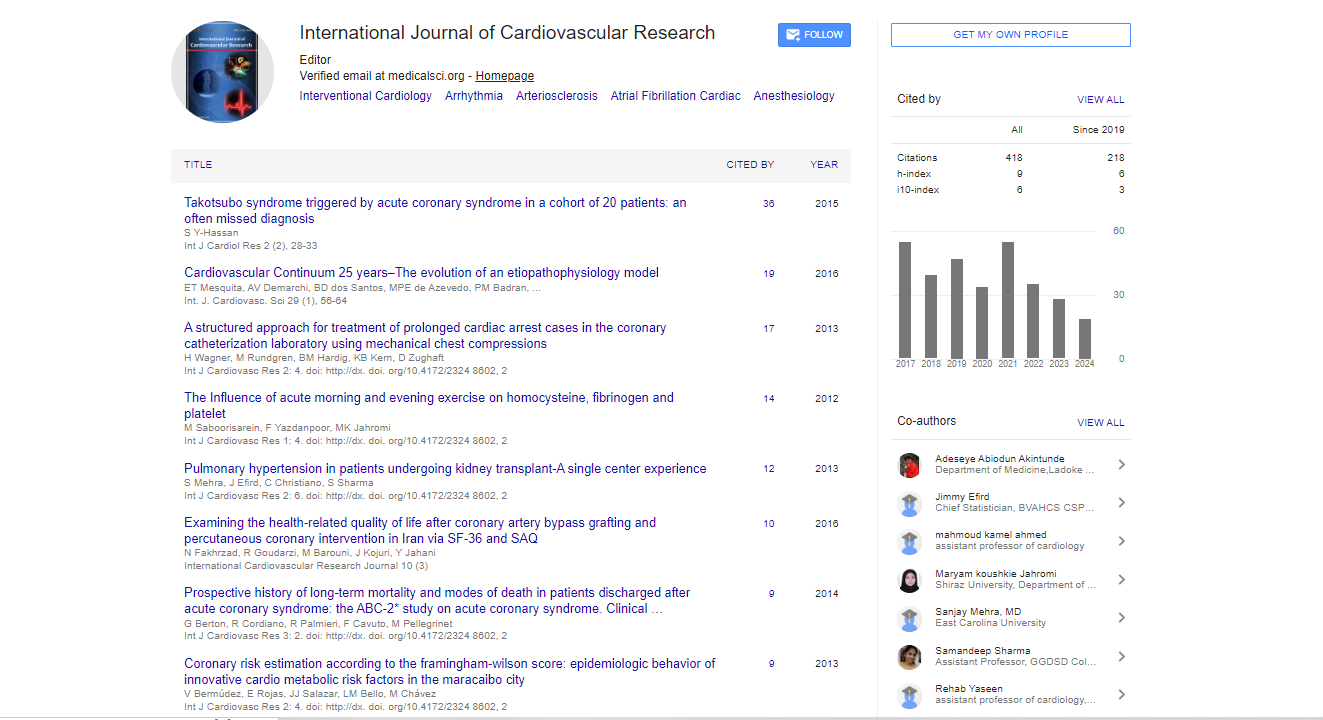Opinion Article, Int J Cardiol Res Vol: 13 Issue: 6
Pathophysiology and Management of Cardiometabolic Disorders
Emily Carter*
1Department of Cardiology, University College London (UCL), London, United Kingdom
*Corresponding Author: Emily Carter,
Department of Cardiology, University
College London (UCL), London, United Kingdom
E-mail: emily.carter@ucl.ac.uk
Received date: 28 November, 2024 Manuscript No. ICRJ-24-156837;
Editor assigned date: 02 December, 2024, PreQC No. ICRJ-24-156837 (PQ);
Reviewed date: 16 December, 2024, QC No. ICRJ-24-156837;
Revised date: 23 December, 2024, Manuscript No. ICRJ-24-156837 (R);
Published date: 30 December, 2024, DOI: 10.4172/2324-8602.1000599.
Citation: Carter E (2024) Pathophysiology and Management of Cardiometabolic Disorders. Int J Cardiol Res 13:6.
Description
Cardiometabolic disorders, a term that encompasses a range of interconnected conditions affecting both the heart and metabolic system, have emerged as a significant public health issue worldwide. These disorders, including obesity, type 2 diabetes, hypertension, dyslipidemia and Cardiovascular Diseases (CVD), are characterized by their mutual risk factors, such as poor diet, physical inactivity, genetic predisposition and environmental influences. Their growing prevalence has placed an immense strain on healthcare systems globally, demanding urgent attention and intervention to reduce the burden they impose on society. Type 2 diabetes, one of the most prevalent cardiometabolic disorders, is a result of chronic insulin resistance, where the body’s cells fail to respond to insulin effectively, leading to elevated blood glucose levels. Over time, the condition can result in severe complications, including kidney disease, nerve damage and an increased risk of cardiovascular disease. Hypertension, or high blood pressure, is another indication of cardiometabolic disorders. Persistent hypertension places undue strain on the heart and blood vessels, increasing the risk of stroke, heart failure and kidney disease. Likewise, dyslipidemia characterized by abnormal lipid levels such as high cholesterol and triglyceridescan contribute to atherosclerosis, a condition that narrows the arteries, further heightening the risk of cardiovascular events.
Pathophysiology
The basic pathophysiology of cardiometabolic disorders involves complex interactions between genetic, environmental and lifestyle factors. Obesity, particularly abdominal obesity, plays a central role in the development of insulin resistance. Adipose tissue, especially visceral fat, releases pro-inflammatory cytokines and adipokines, such as leptin and resistin, which contribute to systemic inflammation and alter insulin signaling pathways. This inflammatory environment interferes with the body’s ability to utilize glucose and fatty acids efficiently, ultimately leading to elevated blood glucose and lipid levels, which are key features of metabolic syndrome. In individuals with hypertension, the persistent elevation of blood pressure leads to endothelial dysfunction, a condition where the blood vessels become less responsive to vasodilation. This increases vascular resistance, further exacerbating hypertension. The chronic strain on the heart and blood vessels can also lead to Left Ventricular Hypertrophy (LVH), a condition in which the heart’s left ventricle thickens and becomes less efficient at pumping blood. This increases the risk of heart failure and other cardiovascular complications. The relationship between dyslipidemia and cardiovascular disease is well-established. Elevated levels of Low-Density Lipoprotein (LDL) cholesterol, commonly known as "bad" cholesterol, promote the formation of fatty plaques in the arteries, a process known as atherosclerosis. Over time, these plaques can rupture, causing blood clots to form, which can block blood flow to vital organs such as the heart and brain, leading to heart attacks and strokes.
Treatment and management
The treatment and management of cardiometabolic disorders require a multifaceted approach that includes lifestyle changes, pharmacological interventions and, in some cases, surgical procedures. Medications such as antihypertensives, statins and metformin are commonly prescribed to manage blood pressure, lipid levels and blood glucose, respectively. For individuals with severe obesity, bariatric surgery may be considered as a last resort to promote weight loss and reduce the risk of comorbid conditions. In addition to pharmaceutical treatments, ongoing monitoring and support are essential for individuals with cardiometabolic disorders. Regular check-ups with healthcare providers to assess blood pressure, lipid levels, blood glucose and weight are important for managing these conditions and preventing complications. Furthermore, patient education and selfmanagement strategies, including dietary counseling, physical activity plans and stress reduction techniques, are important for improving long-term outcomes.
Conclusion
Cardiometabolic disorders are a growing global health challenge, with complex interactions between genetic, lifestyle and environmental factors contributing to their prevalence. The rising rates of obesity, type 2 diabetes, hypertension and cardiovascular diseases place a heavy burden on individuals and healthcare systems worldwide. However, with a focus on prevention, early detection and effective management through lifestyle changes and appropriate medical interventions, it is possible to reduce the impact of these disorders and improve the overall health and well-being of affected populations.
 Spanish
Spanish  Chinese
Chinese  Russian
Russian  German
German  French
French  Japanese
Japanese  Portuguese
Portuguese  Hindi
Hindi 



